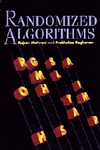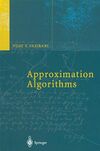imported>Etone |
imported>Etone |
| Line 1: |
Line 1: |
| == Lovász Local Lemma== | | {{Infobox |
| Given a sequence of events <math>A_1,A_2,\ldots,A_n</math>, we use the '''dependency graph''' to describe the dependencies between these events.
| | |name = Infobox |
| | |bodystyle = |
| | |title = <font size=3>高级算法 |
| | <br>Advanced Algorithms</font> |
| | |titlestyle = |
|
| |
|
| {{Theorem
| | |image = |
| |Definition| | | |imagestyle = |
| :Let <math>A_1,A_2,\ldots,A_n</math> be a sequence of events. A graph <math>D=(V,E)</math> on the set of vertices <math>V=\{1,2,\ldots,n\}</math> is called a '''dependency graph''' for the events <math>A_1,\ldots,A_n</math> if for each <math>i</math>, <math>1\le i\le n</math>, the event <math>A_i</math> is mutually independent of all the events <math>\{A_j\mid (i,j)\not\in E\}</math>. | | |caption = |
| }}
| | |captionstyle = |
| | |headerstyle = background:#ccf; |
| | |labelstyle = background:#ddf; |
| | |datastyle = |
|
| |
|
| The notion of mutual independence between an event and a set of events is formally defined as follows.
| | |header1 =Instructor |
| {{Theorem|Definition|
| | |label1 = |
| :An event <math>A</math> is said to be '''mutually independent''' of events <math>B_1,B_2,\ldots, B_k</math>, if for any disjoint <math>I^+,I^-\subseteq\{1,2,lots,k\}</math>, it holds that
| | |data1 = |
| ::<math>\Pr\left[A\mid \bigwedge_{i\in I^+}B_i\wedge \bigwedge_{i\in I^-}\overline{B_i}\right]=\Pr[A]</math>. | | |header2 = |
| | |label2 = |
| | |data2 = 尹一通<br>郑朝栋 |
| | |header3 = |
| | |label3 = Email |
| | |data3 = yinyt@nju.edu.cn chaodong@nju.edu.cn |
| | |header4 = |
| | |label4= office |
| | |data4= 计算机系 804 |
| | |header5 = Class |
| | |label5 = |
| | |data5 = |
| | |header6 = |
| | |label6 = Class meetings |
| | |data6 = Wednesday, 8am-10am <br> 仙I-319 |
| | |header7 = |
| | |label7 = Place |
| | |data7 = |
| | |header8 = |
| | |label8 = Office hours |
| | |data8 = Wednesday, 10am-12pm <br>计算机系 804(尹一通)、302(郑朝栋) |
| | |header9 = Textbooks |
| | |label9 = |
| | |data9 = |
| | |header10 = |
| | |label10 = |
| | |data10 = [[File:MR-randomized-algorithms.png|border|100px]] |
| | |header11 = |
| | |label11 = |
| | |data11 = Motwani and Raghavan. <br>''Randomized Algorithms''.<br> Cambridge Univ Press, 1995. |
| | |header12 = |
| | |label12 = |
| | |data12 = [[File:Approximation_Algorithms.jpg|border|100px]] |
| | |header13 = |
| | |label13 = |
| | |data13 = Vazirani. <br>''Approximation Algorithms''. <br> Springer-Verlag, 2001. |
| | |belowstyle = background:#ddf; |
| | |below = |
| }} | | }} |
|
| |
|
| ;Example
| | This is the webpage for the ''Advanced Algorithms'' class of fall 2018. Students who take this class should check this page periodically for content updates and new announcements. |
| :Let <math>X_1,X_2,\ldots,X_m</math> be a set of ''mutually independent'' random variables. Each event <math>A_i</math> is a predicate defined on a number of variables among <math>X_1,X_2,\ldots,X_m</math>. Let <math>v(A_i)</math> be the unique smallest set of variables which determine <math>A_i</math>. The dependency graph <math>D=(V,E)</math> is defined by
| |
| :::<math>(i,j)\in E</math> iff <math>v(A_i)\cap v(A_j)\neq \emptyset</math>.
| |
|
| |
|
| The following lemma, known as the Lovász local lemma, first proved by Erdős and Lovász in 1975, is an extremely powerful tool, as it supplies a way for dealing with rare events.
| | = Announcement = |
| | * (2018/9/5) 新学期第一次上课。 |
|
| |
|
| {{Theorem
| | = Course info = |
| |Lovász Local Lemma (symmetric case)|
| | * '''Instructor ''': 尹一通、郑朝栋 |
| :Let <math>A_1,A_2,\ldots,A_n</math> be a set of events, and assume that the following hold: | | :*email: yinyt@nju.edu.cn, chaodong@nju.edu.cn |
| :#for all <math>1\le i\le n</math>, <math>\Pr[A_i]\le p</math>;
| | * '''Class meeting''': Wednesday 8am-10am, 仙I-319. |
| :#the maximum degree of the dependency graph for the events <math>A_1,A_2,\ldots,A_n</math> is <math>d</math>, and | | * '''Office hour''': Wednesday 10am-12pm, 计算机系 804. |
| :::<math>ep(d+1)\le 1</math>.
| |
| :Then | |
| ::<math>\Pr\left[\bigwedge_{i=1}^n\overline{A_i}\right]>0</math>.
| |
| }}
| |
|
| |
|
| We will prove a general version of the local lemma, where the events <math>A_i</math> are not symmetric. This generalization is due to Spencer.
| | = Syllabus = |
| {{Theorem
| |
| |Lovász Local Lemma (general case)|
| |
| :Let <math>D=(V,E)</math> be the dependency graph of events <math>A_1,A_2,\ldots,A_n</math>. Suppose there exist real numbers <math>x_1,x_2,\ldots, x_n</math> such that <math>0\le x_i<1</math> and for all <math>1\le i\le n</math>,
| |
| ::<math>\Pr[A_i]\le x_i\prod_{(i,j)\in E}(1-x_j)</math>.
| |
| :Then
| |
| ::<math>\Pr\left[\bigwedge_{i=1}^n\overline{A_i}\right]\ge\prod_{i=1}^n(1-x_i)</math>.
| |
| }}
| |
|
| |
|
| To see that the general LLL implies symmetric LLL, we set <math>x_i=\frac{1}{d+1}</math> for all <math>i=1,2,\ldots,n</math>. Then we have <math>\left(1-\frac{1}{d+1}\right)^d>\frac{1}{\mathrm{e}}</math>.
| | === 先修课程 Prerequisites === |
| | * 必须:离散数学,概率论,线性代数。 |
| | * 推荐:算法设计与分析。 |
|
| |
|
| Assume the condition in the symmetric LLL:
| | === Course materials === |
| :#for all <math>1\le i\le n</math>, <math>\Pr[A_i]\le p</math>;
| | * [[高级算法 (Fall 2018) / Course materials|<font size=3>教材和参考书</font>]] |
| :#<math>ep(d+1)\le 1</math>;
| |
| then it is easy to verify that for all <math>1\le i\le n</math>,
| |
| :<math>\Pr[A_i]\le p\le\frac{1}{e(d+1)}<\frac{1}{d+1}\left(1-\frac{1}{d+1}\right)^d\le x_i\prod_{(i,j)\in E}(1-x_j)</math>.
| |
| Due to the general LLL, we have
| |
| :<math>\Pr\left[\bigwedge_{i=1}^n\overline{A_i}\right]\ge\prod_{i=1}^n(1-x_i)=\left(1-\frac{1}{d+1}\right)^n>0</math>.
| |
| This proves the symmetric LLL.
| |
|
| |
|
| Now we prove the general LLL by the original induction proof.
| | === 成绩 Grades === |
| {{Proof|
| | * 课程成绩:本课程将会有若干次作业和一次期末考试。最终成绩将由平时作业成绩和期末考试成绩综合得出。 |
| First, apply the chain rule. We have
| | * 迟交:如果有特殊的理由,无法按时完成作业,请提前联系授课老师,给出正当理由。否则迟交的作业将不被接受。 |
| :<math>\Pr\left[\bigwedge_{i=1}^n\overline{A_i}\right]=\prod_{i=1}^n\Pr\left[\overline{A_i}\mid \bigwedge_{j=1}^{i-1}\overline{A_{j}}\right]=\prod_{i=1}^n\left(1-\Pr\left[{A_i}\mid \bigwedge_{j=1}^{i-1}\overline{A_{j}}\right]\right)</math>.
| |
|
| |
|
| Next we prove by induction on <math>m</math> that for any set of <math>m</math> events <math>i_1,\ldots,i_m</math>,
| | === <font color=red> 学术诚信 Academic Integrity </font>=== |
| :<math>\Pr\left[A_{i_1}\mid \bigwedge_{j=2}^m\overline{A_{i_j}}\right]\le x_{i_1}</math>.
| | 学术诚信是所有从事学术活动的学生和学者最基本的职业道德底线,本课程将不遗余力的维护学术诚信规范,违反这一底线的行为将不会被容忍。 |
| The local lemma follows immediately by the above chain rule.
| |
|
| |
|
| For <math>m=1</math>, this is obvious because
| | 作业完成的原则:署你名字的工作必须由你完成。允许讨论,但作业必须独立完成,并在作业中列出所有参与讨论的人。不允许其他任何形式的合作——尤其是与已经完成作业的同学“讨论”。 |
| :<math>\Pr[A_{i_1}]\le x_{i_1}\prod_{(i_1,j)\in E}(1-x_j)\le x_{i_1}</math>.
| |
|
| |
|
| For general <math>m</math>, let <math>i_2,\ldots,i_k</math> be the set of vertices adjacent to <math>i_1</math> in the dependency graph, i.e. event <math>A_{i_1}</math> is mutually independent of <math>A_{i_{k+1}},A_{i_{k+2}},\ldots, A_{i_{m}}</math>.
| | 本课程将对剽窃行为采取零容忍的态度。在完成作业过程中,对他人工作(出版物、互联网资料、其他人的作业等)直接的文本抄袭和对关键思想、关键元素的抄袭,按照 [http://www.acm.org/publications/policies/plagiarism_policy ACM Policy on Plagiarism]的解释,都将视为剽窃。剽窃者成绩将被取消。如果发现互相抄袭行为,<font color=red> 抄袭和被抄袭双方的成绩都将被取消</font>。因此请主动防止自己的作业被他人抄袭。 |
| By conditional probability, we have
| |
| :<math>
| |
| \Pr\left[A_{i_1}\mid \bigwedge_{j=2}^m\overline{A_{i_j}}\right]
| |
| =\frac{\Pr\left[ A_i\wedge \bigwedge_{j=2}^k\overline{A_{i_j}}\mid \bigwedge_{j=k+1}^m\overline{A_{i_j}}\right]}
| |
| {\Pr\left[\bigwedge_{j=2}^k\overline{A_{i_j}}\mid \bigwedge_{j=k+1}^m\overline{A_{i_j}}\right]}
| |
| </math>.
| |
| First, we bound the numerator. Due to that <math>A_{i_1}</math> is mutually independent of <math>A_{i_{k+1}},A_{i_{k+2}},\ldots, A_{i_{m}}</math>, we have
| |
| :<math>
| |
| \begin{align}
| |
| \Pr\left[ A_{i_1}\wedge \bigwedge_{j=2}^k\overline{A_{i_j}}\mid \bigwedge_{j=k+1}^m\overline{A_{i_j}}\right]
| |
| &\le\Pr\left[ A_{i_1}\mid \bigwedge_{j=k+1}^m\overline{A_{i_j}}\right]\\
| |
| &=\Pr[A_{i_1}]\\
| |
| &\le x_{i_1}\prod_{(i_1,j)\in E}(1-x_j).
| |
| \end{align}
| |
| </math> | |
|
| |
|
| Next, we bound the denominator. Applying the chain rule, we have
| | 学术诚信影响学生个人的品行,也关乎整个教育系统的正常运转。为了一点分数而做出学术不端的行为,不仅使自己沦为一个欺骗者,也使他人的诚实努力失去意义。让我们一起努力维护一个诚信的环境。 |
| :<math>
| |
| \Pr\left[\bigwedge_{j=2}^k\overline{A_{i_j}}\mid \bigwedge_{j=k+1}^m\overline{A_{i_j}}\right]
| |
| =\prod_{j=2}^k\Pr\left[\overline{A_{i_j}}\mid \bigwedge_{\ell=j+1}^m\overline{A_{i_\ell}}\right]
| |
| </math>
| |
| which by the induction hypothesis, is at least
| |
| :<math>
| |
| \prod_{j=2}^k(1-x_{i_j})=\prod_{\{i_1,i_j\}\in E}(1-x_j)
| |
| </math>
| |
| where <math>E</math> is the set of edges in the dependency graph.
| |
|
| |
|
| Altogether, we prove the induction hypothesis
| | = Assignments = |
| :<math>
| | * TBA |
| \Pr\left[A_{i_1}\mid \bigwedge_{j=2}^m\overline{A_{i_j}}\right]
| |
| \le\frac{x_{i_1}\prod_{(i_1,j)\in E}(1-x_j)}{\prod_{\{i_1,i_j\}\in E}(1-x_j)}\le x_{i_1}.
| |
| </math>
| |
|
| |
|
| Due to the chain rule, it holds that
| | = Lecture Notes = |
| :<math>
| | # [[高级算法 (Fall 2018)/Min-Cut and Max-Cut|Min-Cut and Max-Cut]] |
| \begin{align}
| | #: [[高级算法 (Fall 2018)/Probability Basics|Probability basics]] |
| \Pr\left[\bigwedge_{i=1}^n\overline{A_i}\right]
| |
| &=\prod_{i=1}^n\Pr\left[\overline{A_i}\mid \bigwedge_{j=1}^{i-1}\overline{A_{j}}\right]\\
| |
| &=\prod_{i=1}^n\left(1-\Pr\left[A_i\mid \bigwedge_{j=1}^{i-1}\overline{A_{j}}\right]\right)\\
| |
| &\ge\prod_{i=1}^n\left(1-x_i\right).
| |
| \end{align}
| |
| </math>
| |
| }}
| |

